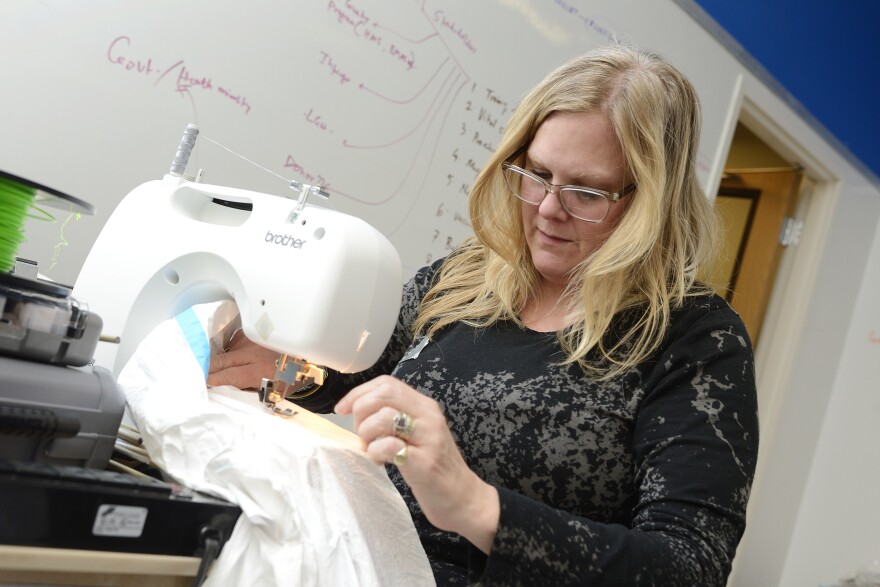
For the past 25 years, Jill Andrews has been making extravagant dresses for brides and whimsical costumes for actors. But this past weekend, the 47-year-old wedding gown designer from Baltimore used her sewing skills to create a different kind of garment: an anti-Ebola protection suit.
Andrews was one of 65 people taking part in an Ebola suit design challenge last weekend, organized by global health nonprofit Jhpiego and Johns Hopkins University. There were engineering students, public health workers and virologists in the mix. And one seamstress: Andrews.
But she wasn't really an oddball choice for the event.
We first heard about Andrews on an interview with Public Radio International. Intrigued, we reached out to her. Turns out, wedding gowns and personal protective garb aren't an odd couple. "They have to be very carefully constructed and thoughtfully taken off and put on," she says
Between disinfecting the outer gloves, removing the goggles and washing your hands, there are 19 steps to taking off an Ebola suit — 24, if you count the inspection protocols before and after the suit comes off.
Health workers must perform each step with great care in case there are bits of virus on their gear. But accidental exposure can happen if they're tired, hot and in a hurry. So suits need to be cooler and easier to take off, says Dr. Chandrakant Ruparelia, senior technical advisor at Jhpiego.
Andrews says when organizers demonstrated how to take off a protective suit, step by step, it was akin to watching a "horror show."
"You just saw so many — literally — holes in the process," she says. "[The demonstrators] were doing it in an air-conditioned room and they weren't tired, and they were making so many mistakes." One woman's hair kept falling in her face, and Andrews says it made her cringe each time a suit wearer's hands got close to his or her face.
The participants formed eight teams and went straight to work. By the end of the weekend, they'd used plastic sheets, zippers, and even cardboard and pipe cleaners to build prototypes. Andrews says they will meet up again this Sunday to refine their designs.
Madeleine Clegg, a biomedical engineering student at Hopkins, got an adrenaline rush from doing so much in so little time. She says the quick pace helped narrow ideas to the best: "We aimed for solutions that were tangible to design in a relatively short amount of time."
That's because the ideal designs and modifications would have to be implemented in just a few months. "This is an emergency," says Dr. Harshad Sanghvi, vice president of innovations at Jhpiego and one of the event's organizers.

In a challenge like this, the diversity of "unlike minds" is key, he says. Engineering students like Clegg knew about medical devices, public health workers made sure designs were suitable for the working environment and virologists taught everyone how a virus is contracted. There was even an architect who helped his team design a special tent to treat patients.
As a gown designer, Andrews knows how to make clothing for different body types. And being a costume designer for some 15 years gave her a creative mind. "I had to make costumes all kinds of crazy," she says. "Something as simple as making an actor's pants fall off at just the right moment is so ridiculously hard."
Her theatrical experience got her thinking about how workers can take off their suits without having to touch any parts of their bodies.
Her sewing experience was also a big plus. "At one point, there was a little line of people holding zippers and Velcro's asking me, 'Can you sew the gloves onto this Tyvek arm?'" she says with a laugh.
And were there sweetheart necklines and long trains for the PPE? Andrews says that for the moment, she's sworn to secrecy about the designs.
Copyright 2021 NPR. To see more, visit https://www.npr.org. 9(MDAxMTMyMDY2MDEyNDUxNzAyNjlmODI5NQ004))


